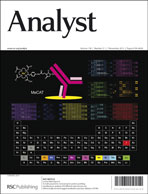Stimulation and release from neurons via a dual capillary collection device interfaced to mass spectrometry†
Abstract
Neuropeptides are cell to cell signaling molecules that modulate a wide range of physiological processes. Neuropeptide release has been studied in sample sizes ranging from single cells and neuronal clusters, to defined brain nuclei and large brain regions. We have developed and optimized cell stimulation and collection approaches for the efficient measurement of neuropeptide release from neuronal samples using a dual capillary system. The defining feature is a capillary that contains octadecyl-modified silica nanoparticles on its inner wall to capture and extract releasates. This collection capillary is inserted into another capillary used to deliver solutions that chemically stimulate the cells, with solution flowing up the inner capillary to facilitate peptide collection. The efficiency of peptide collection was evaluated using six peptide standards mixed in physiological saline. The extracted peptides eluted from these capillaries were characterized via matrix-assisted laser desorption/ionization time-of-flight mass spectrometry (MALDI-TOF MS) with low femtomole detection limits. Using the capillary collection system in small custom-fabricated culturing chambers, individual cultured neurons and neuronal clusters from the model animal Aplysia californica were stimulated with distinct neuronal secretagogues and the releasates were collected and characterized using MALDI-TOF MS.


 Please wait while we load your content...
Please wait while we load your content...